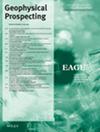通过对 P 波和 SH 波数据进行二维全波形反演,对多分量地震数据进行深度成像:SEAM II 巴雷特模型研究
IF 1.8
3区 地球科学
Q3 GEOCHEMISTRY & GEOPHYSICS
引用次数: 0
摘要
我们通过生成由 SEAM II Barrett 非常规模型模拟的压缩波(P 波)、转换波(PS 波)和水平极化剪切波(SH 剪切波)数据的基尔霍夫深度迁移图像,检验了九分量地震勘探的价值。我们首先利用全波形反演,从 P 波数据中获得 P 波速度模型,从 SH 波数据中获得 S 波速度模型。在假设地下各向同性的前提下,P 波和 SH 波数据的最大频率均为 20 赫兹。为了实现全波形反演,我们使用了二维时域有限差分法和 L2 准则来测量数据的不拟合度。我们利用 P 波和 SH 波数据中的折射和反射来重建从地表到储层的 P 波和 S 波速度模型。反演的 P 波和 S 波速度包含了模型的主要特征(如主要断层和通道),但由于频率限制,在估算模型前 300 米深度内的高频速度变化时存在一定困难。然后,我们利用反演的 P 波和 S 波速度,从 P 波、PS 波和 SH 波数据中生成基尔霍夫深度迁移集和图像。平坦的 P 波和 SH 波共像偏移集波表明,SH 波和 P 波全波形反演可以生成足够的 S 波和 P 波速度,用于迁移。同时使用反演的 P 波和 S 波速度,也可获得平坦的 PS 波集聚和清晰的 PS 波迁移图像。这一结果表明,从 SH 波数据中获取 S 波速度有助于 PS 波数据的处理和成像。此外,径向分量的 SH 波图像和 S 波图像能更好地划分储层内的断层面和小尺度地质体,因为在记录相似频率范围的情况下,S 波的波长比 P 波小。因此,我们的研究表明,通过对 SH 波数据进行二维全波形反演,可以成功构建 S 波速度。与传统的 P 波成像相比,随后的多分量地震数据成像提高了对某些非常规储层的划分。本文章由计算机程序翻译,如有差异,请以英文原文为准。
Depth imaging of multicomponent seismic data through the application of 2D full‐waveform inversion to P‐ and SH‐wave data: SEAM II Barrett model study
We examine the value of the nine‐component seismic survey by generating the Kirchhoff depth migration images of compressional wave (P‐wave), converted wave (PS‐wave) and horizontally polarized shear wave (SH shear wave) data simulated from the SEAM II Barrett unconventional model. We first utilize full waveform inversion to obtain a P‐wave velocity model from P‐wave data and an S‐wave velocity model from SH‐wave data. Both P‐wave and SH‐wave data are generated with the maximum frequency of 20 Hz while assuming that the subsurface is isotropic. To implement full waveform inversion, we use a two‐dimensional time‐domain finite‐difference method and the L2 norm to measure the data misfit. We use both refractions and reflections in P‐ and SH‐wave data to reconstruct the P‐ and S‐wave velocity models from the surface to the reservoir. The inverted P‐ and S‐wave velocities contain the main features of the model (e.g., major faults and channels) but have some difficulties in estimating high‐frequency velocity variation within the first 300‐m depth of the model due to the frequency constraint. We then use the inverted P‐ and S‐wave velocities to generate Kirchhoff depth migration gathers and images from the P‐, PS‐ and SH‐wave data. The flat P‐ and SH‐wave common‐image offset gathers suggest that SH‐ and P‐wave full waveform inversion can generate adequate S‐ and P‐wave velocities for migration. Flat PS‐wave gathers and the clear PS‐wave migration image are also obtained using the inverted P‐ and S‐wave velocities simultaneously. This result indicates that obtaining S‐wave velocities from SH‐wave data can aid PS‐wave data processing and imaging. Moreover, the SH‐wave images and S‐wave images of the radial component provide better delineation of fault planes and small‐scale geobodies within the reservoir since the wavelength of the S‐wave is smaller compared to P‐wave when similar frequency ranges are recorded. Therefore, our study shows that S‐wave velocities can be successfully constructed by the two‐dimensional full waveform inversion application of the SH‐wave data. The subsequent imaging of multicomponent seismic data improves the delineation of certain unconventional reservoirs compared to the traditional P‐wave imaging.
求助全文
通过发布文献求助,成功后即可免费获取论文全文。
去求助
来源期刊

Geophysical Prospecting
地学-地球化学与地球物理
CiteScore
4.90
自引率
11.50%
发文量
118
审稿时长
4.5 months
期刊介绍:
Geophysical Prospecting publishes the best in primary research on the science of geophysics as it applies to the exploration, evaluation and extraction of earth resources. Drawing heavily on contributions from researchers in the oil and mineral exploration industries, the journal has a very practical slant. Although the journal provides a valuable forum for communication among workers in these fields, it is also ideally suited to researchers in academic geophysics.
 求助内容:
求助内容: 应助结果提醒方式:
应助结果提醒方式:


